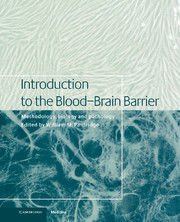Book contents
- Frontmatter
- Contents
- List of contributors
- 1 Blood–brain barrier methodology and biology
- Part I Methodology
- 2 The carotid artery single injection technique
- 3 Development of Brain Efflux Index (BEI) method and its application to the blood–brain barrier efflux transport study
- 4 In situ brain perfusion
- 5 Intravenous injection/pharmacokinetics
- 6 Isolated brain capillaries: an in vitro model of blood–brain barrier research
- 7 Isolation and behavior of plasma membrane vesicles made from cerebral capillary endothelial cells
- 8 Patch clamp techniques with isolated brain microvessel membranes
- 9 Tissue culture of brain endothelial cells – induction of blood–brain barrier properties by brain factors
- 10 Brain microvessel endothelial cell culture systems
- 11 Intracerebral microdialysis
- 12 Blood–brain barrier permeability measured with histochemistry
- 13 Measuring cerebral capillary permeability–surface area products by quantitative autoradiography
- 14 Measurement of blood–brain barrier in humans using indicator diffusion
- 15 Measurement of blood–brain permeability in humans with positron emission tomography
- 16 Magnetic resonance imaging of blood–brain barrier permeability
- 17 Molecular biology of brain capillaries
- Part II Transport biology
- Part III General aspects of CNS transport
- Part IV Signal transduction/biochemical aspects
- Part V Pathophysiology in disease states
- Index
16 - Magnetic resonance imaging of blood–brain barrier permeability
from Part I - Methodology
Published online by Cambridge University Press: 10 December 2009
- Frontmatter
- Contents
- List of contributors
- 1 Blood–brain barrier methodology and biology
- Part I Methodology
- 2 The carotid artery single injection technique
- 3 Development of Brain Efflux Index (BEI) method and its application to the blood–brain barrier efflux transport study
- 4 In situ brain perfusion
- 5 Intravenous injection/pharmacokinetics
- 6 Isolated brain capillaries: an in vitro model of blood–brain barrier research
- 7 Isolation and behavior of plasma membrane vesicles made from cerebral capillary endothelial cells
- 8 Patch clamp techniques with isolated brain microvessel membranes
- 9 Tissue culture of brain endothelial cells – induction of blood–brain barrier properties by brain factors
- 10 Brain microvessel endothelial cell culture systems
- 11 Intracerebral microdialysis
- 12 Blood–brain barrier permeability measured with histochemistry
- 13 Measuring cerebral capillary permeability–surface area products by quantitative autoradiography
- 14 Measurement of blood–brain barrier in humans using indicator diffusion
- 15 Measurement of blood–brain permeability in humans with positron emission tomography
- 16 Magnetic resonance imaging of blood–brain barrier permeability
- 17 Molecular biology of brain capillaries
- Part II Transport biology
- Part III General aspects of CNS transport
- Part IV Signal transduction/biochemical aspects
- Part V Pathophysiology in disease states
- Index
Summary
Introduction
Magnetic resonance imaging is a sensitive method to detect disease in the central nervous system and monitor its progress. The magnetic resonance technique particularly reflects the amount of tissue water predominantly in the extracellular compartment. Experimental studies have shown its ability to monitor inflammation in the tissue (Hawkins et al., 1990) and also to discriminate extracellular from intracellular edema, and gliosis (Barnes et al., 1987, 1988).
With the introduction of the contrast agent gadolinium-DTPA, it is possible to detect bloodbrain barrier breakdown in vivo (Weinmann et al., 1984; Hawkins et al., 1990, 1992). For example, in multiple sclerosis gadolinium enhancement has been shown to be a frequent, early and important feature of the evolving multiple sclerosis plaque and has been used in recent treatment trials as a marker of inflammatory disease activity (Grossman et al., 1986; Gonzalez-Scarano et al., 1987; Kappos et al., 1988; Miller et al., 1988; Kermode et al., 1990)-see Fig. 16.1.
In early studies gadolinium enhanced MRI was used to assess the degree and distribution of Blood–brain barrier breakdown in experimental allergic encephalomyelitis, an animal model similar to multiple sclerosis. The pattern of barrier breakdown in the acute phase of the condition was compared to that of chronic relapsing disease (Hawkins et al., 1991).
- Type
- Chapter
- Information
- Introduction to the Blood-Brain BarrierMethodology, Biology and Pathology, pp. 147 - 150Publisher: Cambridge University PressPrint publication year: 1998



